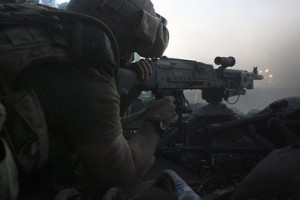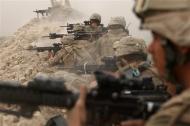Enemy activity appears to be increasing in Afghanistan according to ISAF medical personnel.
U.S. commanders have been braced for a “spring offensive”, a pick-up in violence tied to the season, when warmer weather allows the Taliban to work their way over the mountains from hideouts in north-western Pakistan and into Afghanistan.
In the first few weeks of this spring, there was little change in the level of violence compared with last year, officers say. But in recent days, at least in one key region along the border, that picture has shifted, even if it may be still too early to say that a renewed Taliban offensive has started.
“A lot of things are starting to happen in the area,” Lieutenant-Colonel Kathy Ponder, the chief nurse at the combat support hospital, which put out the call for more blood to treat the wounded from a roadside bomb, told Reuters on Thursday.
“The Taliban seem to be picking up on the IED (improvised explosive device) blasts and we’re getting a lot of gunshot wounds. The intel we’re getting is that they are targeting our area, so we’re ready. We’re making sure we’re overstocked on what we need.”
Wednesday afternoon’s attack, just north of the city of Khost, near the Pakistan border, targeted a U.S. military patrol. Two U.S. soldiers and one U.S. civilian were killed, and two U.S. soldiers were wounded. The wounded pair lost both of their legs, hence the call for large amounts of blood.
But according to U.S. personnel, its all just a myth.
“There is no such thing as a spring offensive,” Colonel Pete Johnson, the commander of a taskforce from the 101st Airborne Division that is responsible for security in six Afghan provinces along the border with Pakistan, told Reuters.
“I think this year this myth is finally going to be debunked. Last year was the same thing — it never materialised. This year it has not materialised and it won’t materialise.”
“Will there be increases in fighting and insurgent activity. Absolutely. But it’s a weather-based construct, a seasonal construct, not a deliberate execution of an offensive. Increased activity is not a coordinated offensive.”
But what difference does this make? This argument has become rather passé. The Taliban know that any “fire and maneuver” engagement of U.S. forces brings a disadvantageous kill ratio. They tried it again in Garmser with the Marines, and lost. This is why The Captain’s Journal had previously clarified the issue of a “spring offensive” in the context of distributed operations and what it does or doesn’t mean. “When NATO speaks of a spring offensive, they are talking tactical maneuvers and larger scale kinetic fights. When we speak of a spring offensive, we are talking about guerrilla tactics – small teams, fire and melt away, etc.”
There has been a disaggreagation of the Taliban into smaller groups of tribal and commander affiliation, fighting for different causes (with the only common goal being the overthrow of the Karzai government), sometimes competing with each other. This makes the notion of a Taliban command and control quaint, but fairly useless (During questioning of the Presidential candidates Bill O’Reilly flatly stated that Taliban command and control was Quetta, and while this might have been true a year ago, it is doubtful that a literal command and control exists for Taliban).
So the supposed spring offensive to which U.S. commanders have so sardonically referred is not applicable to the current scene. We have suggested that the tactics will rely on fire and melt away rather than fire and maneuver, IEDs, suicide tactics, guerrilla tactics and intimidation of the population. In this way, the disaggregation of the enemy along with his focus on terror tactics make Afghanistan look somewhat more like the Anbar Province than it did a year ago.
In Pakistan, Baitullah Mehsud is playing the Pakistani officials for fools as he repeatedly enjoins negotiations, then withdraws from the same, and then hints at them again. Mehsud’s forces, rather than fight the Pakistan Army in fire and maneuver, simply set up a series of checkpoints and road blocks in South Waziristan. The Pakistani Army responded with one of their own. The population tires of this, the Pakistani Army tires of this and agrees to withdraw troops from South Waziristan, and Tehrik-e-Taliban gains their objective.
While Quetta cannot be said to be a literal command and control, as we observed earlier, there are dual Taliban campaigns, one in Pakistan (focused in Waziristan against the Pakistani government, led by Baitullah Mehsud) and the other focused on Afghanistan (focused on Southern Afghanistan where Quetta serves as a rallying point for fighters crossing the border).
Mapping the route the cross-border militants take, Mr Walsh said the insurgents crossed from Balochistan, whose capital Quetta was considered to be the Taliban headquarters by Nato commanders.
“They muster in remote refugee camps west of Quetta — Girdi Jungle is most frequently mentioned — before slipping across the border in four-wheel drive convoys that split up to avoid detection. Sometimes sympathetic border guards help them on their way.
“Inside Afghanistan the fighters thunder across the Dasht-i-Margo — a harsh expanse of ancient smuggling trails which means “desert of death” — before reaching the River Helmand. Here, the sand turns to lush fields of poppy and wheat, and they reach Garmser, home to the most southerly British base in Helmand.”
British officers told Mr Walsh that they had ample evidence that many of the enemy were Pakistani. While remaining coy about their sources of intelligence, they spoke of hearing Punjabi accents and of finding Pakistani papers and telephone contacts on dead fighters.
Four months ago, Den-McKay said, British Gurkhas shot dead a Taliban militant near a small outpost known as Hamburger Hill. Searching the fighter’s body, they discovered a Pakistani identity card and handwritten notes in Punjabi.
There are dual fronts in the campaign, one in Afghanistan and the other in Pakistan. These two fronts are part of the same insurgency / counterinsurgency campaign. The expensive UAVs that fly overhead are merely further testimony to the necessity for force projection on the gound when reports arrive of more young sons of America who have had their legs blown off from IEDs.
Since Afghanistan may more closely resemble Anbar in terms of its reliance on terror tactics, the pretext for success in Anbar becomes all the more important. Al Qaeda terror would have won the day without extreme force projection by the U.S. The Taliban will not engage in fire and maneuver, and arguments about whether a “spring offensive” will materialize are childish, wasteful and irrelevant. The Taliban will engage in fire and melt away, and the chase must ensue to hunt them down and kill them with the utmost violence.





